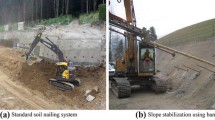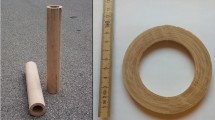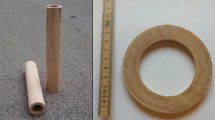Abstract
Circular hollow sections of beech-laminated veneer lumber (LVL) for the use as temporary geotechnical soil nailing systems are currently being developed. Due to their permanent subsoil cement embedment, investigations of the bond line quality of the timber sections are essential. This paper presents the bonding properties of flat and curved beech LVL after cyclic conditioning in a water–cement grout solution aimed at inducing short- and long-term alkaline attack of the timber. In total, 409 and 69 samples were tested in tensile shear tests after short-term and long-term conditioning, respectively. Three different adhesive systems, a one-component polyurethane adhesive, a melamine–urea–formaldehyde adhesive and a melamine–urea–formaldehyde adhesive modified by means of (polyvinyl)-acetate adhesive were investigated and compared. Short-term conditioning by submersion in boiling cement suspension was found to be a reliable method for testing the bonding performance rather than long-term conditioning. In the case of tensile shear tests of samples subjected to long-term treatment, wood material strength was the decisive criterion. Generally, tensile shear test samples of all investigated adhesives achieved reliable bonding for a pressing force up to 1.0 MPa. No relationship was recognised between the determined bonding failure and the wood properties tensile shear strength, wood failure percentage, fracture pattern and bulk density of veneers adjacent to the bond line. For the determination of the bond line integrity of curved veneer poles, it was necessary to test bonding quality in a combined test using curved and flat samples and to compare tensile shear strength with data determined on reference samples in the same veneer population without bond line.











Similar content being viewed by others
References
Bortz J, Schuster C (2010) Statistik für human-und sozialwissenschaftler: (statistics for human and social scientists). Springer, Berlin 7th revised and extended edition
Chang I, Im J, Cho G-C (2016) Introduction of microbial biopolymers in soil treatment for future environmentally-friendly and sustainable geotechnical engineering. Sustainability 8:251. https://doi.org/10.3390/su8030251
EN 13017–2 (2001) Solid wood panels—classification by surface appearance—part 2: hardwood. European Committee for Standardization, Brussels
EN 302–1 (2013) Adhesives for load-bearing timber structures—test methods—part 1: determination of longitudinal tensile shear strength. European Committee for Standardization, Brussels
EN 635–2 (1995) Plywood—classification by surface appearance—part 2: hardwood. European Committee for Standardization, Brussels
EUROSTAT (2017) Eurostat regional yearbook, 2017th edn. Eurostat statistical books. Publications Office of the European Union, Luxembourg
FprCEN/TS 16637-3 (2015) Construction products—assessment of release of dangerous substances—part 3: horizontal up-flow percolation test. European Committee for Standardization, Brussels
Frihart CR (2005) Adhesive bonding and performance testing of bonded wood products. J ASTM Int 2(7):1–12
Frihart CR (2009) Adhesive groups and how they relate to the durability of bonded wood. J Adhes Sci Technol 23:601–617. https://doi.org/10.1163/156856108X379137
Hirschmüller S, Pravida J, Marte R, Flach M (2018a) Adhesive properties of laminated veneer lumber poles for use in temporary soil nailing: development and evaluation of a test method for curved structures in a high-alkaline environment. Wood Sci Technol 52(4):1061–1092
Hirschmüller S, Pravida J, Marte R, Flach M (2018b) Long-term material properties of circular hollow laminated veneer lumber sections under water saturation and cement alkaline attack. Wood Mater Sci Eng 81:1–15. https://doi.org/10.1080/17480272.2018.1434830
Horioka K, Gamoh M (1973) The mechanism and durability of adhesion in wood-glue bonds. In: Proceedings of the IUFRO. Division 5 forest products, IUFRO-5 meeting, pp 508–527
Kläusler O, Hass P, Amen C, Schlegel S, Niemz P (2014) Improvement of tensile shear strength and wood failure percentage of 1C PUR bonded wooden joints at wet stage by means of DMF priming. Eur J Wood Prod 72:343–354. https://doi.org/10.1007/s00107-014-0786-8
Kollmann F (1951) Technologie des Holzes und der Holzwerkstoffe (Technology of wood and wood-based materials). 1 Bd.: Anatomie und Pathologie, Chemie, Physik, Elastizität und Festigkeit (Volume 1: Anatomy and pathology, chemistry, physics, elasticity and strength), 2nd revised and extended edition. Springer, Berlin
prEN 14374 (2016) Timber structures—laminated veneer lumber (LVL)—requirements. European Committee for Standardization, Brussels
Sandermann W, Lüthgens M (1953) Untersuchungen über Verfärbungen von Hölzern (Investigations of discolouration in wood). Holz Roh Werkst 11:435–440. https://doi.org/10.1007/BF02604728
Schmidt M (2014) Die Verklebung von Buchenholz für tragende Holzbauteile unter besonderer Berücksichtigung der Farbverkernung (Bonding beech wood for load-bearing timber structures with particular consideration of coloured cores). Dissertation, Technische Universität München
Wagenführ A (ed) (2012) Taschenbuch der Holztechnik: (Paperback of wood technology), 2nd edn. Carl-Hanser-Verlag, München
Acknowledgements
The authors would like to thank Mr. Alexander Englberger for his great efforts carrying out the tests and Dr. Christian Lehringer (Purbond AG) for providing adhesive and knowledge. The research was supported by the German Federal Ministry of Education and Research, Grant Number 13FH022IX4.
Author information
Authors and Affiliations
Corresponding author
Additional information
Publisher's Note
Springer Nature remains neutral with regard to jurisdictional claims in published maps and institutional affiliations.
Rights and permissions
About this article
Cite this article
Hirschmüller, S., Pravida, J., Marte, R. et al. Adhesive properties of laminated veneer lumber poles for use in temporary soil nailing: bonding performance of curved structures in a high-alkaline environment. Wood Sci Technol 52, 1289–1311 (2018). https://doi.org/10.1007/s00226-018-1031-0
Received:
Published:
Issue Date:
DOI: https://doi.org/10.1007/s00226-018-1031-0




